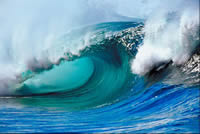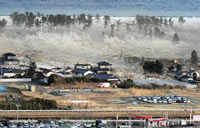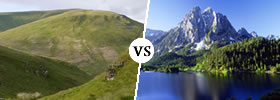Difference between Tidal Wave and Tsunami
Key difference: A tidal wave is essentially a high tide that rises fast enough to appear in the form of a wave. It is solely affected by weather and the gravitational pull from the moon and sun. A tsunami, on the other hand, occurs when some event disturbs the ocean. They are usually caused by a geological event, such as an earthquake, volcanic eruption, or landslide.
 Many consider tidal waves to be synonyms for tsunamis, however scientifically that is incorrect. In fact, tsunamis are not tidal at all. A tidal wave is essentially a high tide that rises fast enough to appear in the form of a wave. It is solely affected by weather and the gravitational pull from the moon and sun. Tides are the rise and fall of sea level that is caused by the gravitational pull of the moon and the sun on the Earth.
Many consider tidal waves to be synonyms for tsunamis, however scientifically that is incorrect. In fact, tsunamis are not tidal at all. A tidal wave is essentially a high tide that rises fast enough to appear in the form of a wave. It is solely affected by weather and the gravitational pull from the moon and sun. Tides are the rise and fall of sea level that is caused by the gravitational pull of the moon and the sun on the Earth.
Tides are not only limited to the oceans, but can also occur in other systems, whenever a gravitational field is present. A majority of the Earth is affected by the gravitational force of the sun, though it is not as easily visible as it is on water. The moon has a more prominent affect on the tides, as it is much closer to the Earth compared to the sun. A wave can also be formed by wind blowing across the surface of the water. These waves are generally known as wind waves.
The term tidal wave is usually used to refer to unusual rise of water alongshore due to strong winds. They are most prominent in narrow bays or in rivers along the coast. The highest “tidal waves” are found in the Bay of Fundy, in the Canadian province of New Brunswick, where the water level can rise with the tide by 50 feet. Tidal waves may raise water level by several feet in just a matter of hours. However, it is also possible that a tidal wave will burn out before it reaches the coast. As a rule, tidal waves follow the currents and are unlikely to cause a landfall in areas of temperate climates or northern countries.
 A tsunami, on the other hand, occurs when some event disturbs the ocean. They are usually caused by a geological event, such as an earthquake, volcanic eruption, or landslide. The water above the event location rises or falls, creating a surface wave that can travel at hundreds of miles an hour.
A tsunami, on the other hand, occurs when some event disturbs the ocean. They are usually caused by a geological event, such as an earthquake, volcanic eruption, or landslide. The water above the event location rises or falls, creating a surface wave that can travel at hundreds of miles an hour.
Tsunami waves differ from normal sea waves, because their wavelength is far longer. Tsunami waves commonly appear as a rapidly rising tide, due to which they are often erroneously referred to as tidal waves. Tsunamis consist of a series of waves that can range over minutes or hours. This is called a "wave train”. Wave heights can vary reaching up to tens of meters in large displacements. Although the impact of tsunamis is limited to coastal areas, their destructive power can be enormous and they can affect entire ocean basins. Furthermore, unlike tidal waves, tsunamis can develop anywhere.
A comparison between tidal waves and tsunamis:
|
|
Tidal Wave |
Tsunami |
|
Definition |
The two great wavelike swellings of the ocean surface that move around the earth on opposite sides and give rise to tide, caused by the attraction of the moon and sun. |
An unusually large sea wave produced by a seaquake or undersea volcanic eruption. |
|
Cause |
Gravitational pull from the moon and sun |
Seaquake or undersea volcanic eruption. |
|
Intensity |
Intensity of tides change depending on location and the position of the earth. Can go as high as 55 feet |
Tsunamis can have wavelengths of up to 200 kilometers and can travel over 800 kilometers per hour. When tsunamis approach shallow water near land masses, the speed decreases, and the amplitude increases very rapidly. |
|
Frequency |
Occurs daily, maybe twice in a day in coastal areas |
Only when there is seismic disturbance in large water bodies. |
|
Location |
Seen mostly in coastal areas. |
Majority of tsunamis (80%) occur in the Pacific Ocean but can occur in any large body of water if the underlying causes are present. |
Image Courtesy: davidblerner.com, britannica.com









Add new comment